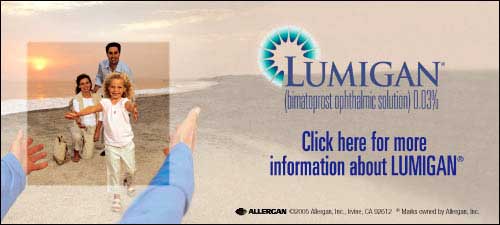
| |
Volume 5, Number 20
|
Monday, May 23, 2005
|

|
||

|
||
| Heritability
of Refractive Error and Familial Aggregation of Myopia in an Elderly Population
Researchers at Johns Hopkins and the NIH’s National Human Genome Research Institute conducted a study aimed at determining the heritability of refractive error and the familial aggregation of myopia in an older population. A total of 759 siblings (mean age, 73.4 years) in 241 families were recruited from the Salisbury Eye Evaluation (SEE) Study in eastern Maryland. Investigators determined refractive error by noncycloplegic subjective refraction, if presenting distance visual acuity was greater than or equal to 20/40; or lensometry, if best corrected visual acuity was greater than 20/40 with spectacles. Participants were considered plano (refractive error of zero) if uncorrected visual acuity was greater than 20/40. Investigators used preoperative refraction from medical records for pseudophakic subjects. They calculated heritability of refractive error using multivariate linear regression and estimated it as twice the residual between-sibling correlation after adjusting for age, gender and race. They used logistic regression models to estimate the odds ratio (OR) of myopia, given a myopic sibling relative to having a nonmyopic sibling. Results showed that the estimated heritability of refractive error was 61 percent (95 percent confidence interval [CI]: 34 percent to 88 percent) in this population. The age-, race- and sex-adjusted ORs of myopia were 2.65 (95 percent CI 1.67 to 4.19), 2.25 (CI 1.31 to 3.87), 3.00 (CI 1.56 to 5.79), and 2.98 (CI 1.51 to 5.87) for myopia thresholds of -0.50, -1.00, -1.50 and -2.00D, respectively. Neither race nor gender was significantly associated with an increased risk of myopia. |
|
SOURCE: Wojciechowski R, Congdon N, Bowie H, et al. Heritability of refractive error and familial aggregation of myopia in an elderly American population. Invest Ophthalmol Vis Sci 2005;46(5):1588-92. |
|

|
||
| Association Between
Intensity of Posterior Capsule Opacification and Visual Acuity
The Medical University of Vienna’s Department of Ophthalmology investigated the correlation between the change in visual acuity and the difference in objective posterior capsule opacification (PCO) scores before and after neodymium:YAG (Nd:YAG) laser capsulotomy. Researchers examined 40 pseudophakic eyes of 35 patients with PCO of varying intensity before and after Nd:YAG laser capsulotomy. They determined visual acuity using the Early Treatment Diabetic Retinopathy Study (ETDRS) chart at 4 m and the Holladay reading chart at 40 cm; they measured pupil diameter under reading conditions each time. They took digital retroillumination images of the posterior capsule, and they evaluated the corresponding area inside the pupil using the Automated Quantification of After-Cataract (AQUA) automated PCO analysis program. The change in visual acuity and difference between PCO scores before and after Nd:YAG laser capsulotomy were calculated for all eyes. The mean AQUA score (scale 0 to 10) was 3.56 before and 0.13 after Nd:YAG laser capsulotomy. The mean ETDRS visual acuity score (logMAR scale) was 0.28 and -0.07, respectively. The correlation coefficient between the differences in PCO score and distance visual acuity was 0.61 and near visual acuity, 0.62. The authors concluded that objective PCO assessment by automated image-analysis systems is a valuable and clinically relevant method for clinical studies of the development and prevention of PCO. |
|
SOURCE: Buehl W, Sacu S, Findl O. Association between intensity of posterior capsule opacification and visual acuity. J Cataract Refract Surg 2005;31(3):543-7. |
|
BRIEFLY
|
|
|
||||||||||||||
| Subscriptions: Review of Ophthalmology Online
is provided free of charge as a service of Jobson Publishing, LLC. If
you enjoy reading Review of Ophthalmology Online, please tell a
friend or colleague about it. Forward this newsletter or send this address:
[email protected].
To change your subscription, reply to this message and give us your old
address and your new address; type "Change of Address" in the
subject line. If you do not want to receive Review of Ophthalmology
Online, reply to this message and type "Unsubscribe: Review of Ophthalmology
Online" in the subject line. Advertising: For information on advertising in this e-mail newsletter or other creative advertising opportunities with Review of Ophthalmology, please contact publisher Rick Bay, or sales managers James Henne, Michele Barrett or Kimberly McCarthy. News: To submit news, send an e-mail, or FAX your news to 610.492.1049 |














